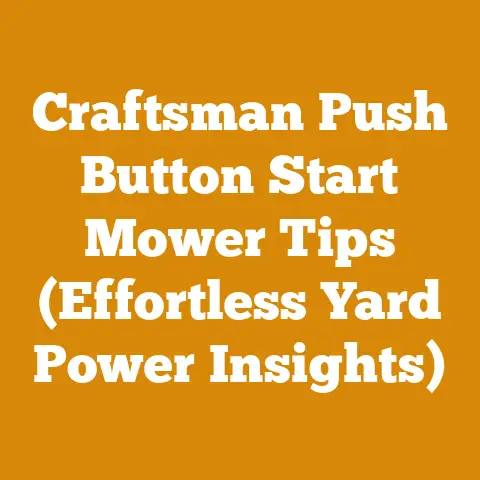Engine for Wood Splitter: Choosing the Right Size (5 Key Tips)
Let’s talk about wood splitters and how to pick the right engine. But before we dive into the nitty-gritty of horsepower and torque, let’s take a quick detour to consider the environmental impact of our wood-splitting endeavors. I always try to be mindful of the resources I use. Choosing a fuel-efficient engine, responsibly sourcing wood, and properly curing firewood are all ways to reduce our footprint. Now, let’s get down to business.
Engine for Wood Splitter: Choosing the Right Size (5 Key Tips)
Choosing the right engine for your wood splitter is crucial. It’s the heart of the machine, dictating how efficiently and effectively you can turn logs into firewood. I’ve seen firsthand the frustration of an underpowered splitter struggling with tough wood, and the overkill of an oversized engine guzzling fuel unnecessarily. Through years of experience and observation, I’ve learned that the sweet spot lies in carefully matching the engine to your specific needs. Let me walk you through the key considerations.
1. Understanding Your Splitting Needs
Before you even think about horsepower, take a hard look at the type of wood you’ll be splitting. Are you dealing with softwoods like pine and fir, or hardwoods like oak, maple, and hickory? The denser the wood, the more power you’ll need.
- Softwoods: These are generally easier to split and require less force. A smaller engine will often suffice.
- Hardwoods: These can be incredibly stubborn, especially if they’re knotty or have twisted grain. You’ll need a more powerful engine to handle them consistently.
I recall one particularly challenging job where I was splitting seasoned oak logs that were nearly three feet in diameter. My smaller splitter, powered by a 5-horsepower engine, simply couldn’t handle them. It would stall out repeatedly, making the job incredibly slow and frustrating. That experience taught me the importance of matching the engine size to the wood I was working with.
Actionable Tip: Make a list of the types of wood you typically split, and estimate the average and maximum diameter of the logs you encounter. This will give you a baseline for determining your power requirements.
2. Horsepower vs. Torque: What Matters Most?
While horsepower is a common metric for engine power, torque is arguably more important for wood splitters. Torque is the rotational force that the engine can generate, and it’s what allows the splitter to overcome the resistance of the wood.
- Horsepower: This is a measure of how quickly the engine can do work. While important, it’s secondary to torque in this application.
- Torque: This is the “muscle” of the engine, and it’s what determines how easily the splitter can power through tough logs.
Think of it this way: horsepower is like speed, while torque is like strength. You need strength to split wood, so focus on engines with high torque ratings.
I’ve seen many people get caught up in horsepower numbers, only to be disappointed when their splitter couldn’t handle the workload.
Actionable Tip: When comparing engines, look for the torque rating in foot-pounds (ft-lbs) or Newton-meters (Nm). A higher number indicates more splitting power.
3. Hydraulic System Considerations
The engine is only one part of the equation. The hydraulic system of your wood splitter plays a crucial role in determining its overall performance. The size of the hydraulic pump and the diameter of the cylinder directly impact the splitting force and speed.
- Hydraulic Pump: This component is responsible for generating the hydraulic pressure that powers the cylinder. A larger pump will typically deliver more oil flow, resulting in faster splitting cycles.
- Cylinder Size: The diameter of the cylinder determines the amount of force that the splitter can exert. A larger cylinder will generate more force, but it will also require more oil flow from the pump.
The engine needs to be properly matched to the hydraulic system to ensure optimal performance. An undersized engine won’t be able to provide enough power to drive the hydraulic pump effectively, while an oversized engine will be inefficient and consume more fuel than necessary.
I once helped a friend upgrade his wood splitter. He installed a larger hydraulic cylinder without upgrading the engine. The result was a splitter that could exert tremendous force, but it was incredibly slow. The engine simply couldn’t keep up with the demands of the larger cylinder. We eventually had to upgrade the engine as well to achieve a balanced system.
Actionable Tip: Consult the specifications of your wood splitter to determine the recommended engine size for your hydraulic system. The manufacturer should provide guidelines based on the pump and cylinder size.
4. Engine Size Recommendations Based on Tonnage
Wood splitters are typically rated by the amount of force they can exert, measured in tons. This tonnage rating is a good indicator of the engine size you’ll need.
- 10-Ton Splitters: These are suitable for light-duty tasks, such as splitting small logs and softwoods. A 5-6.5 horsepower engine is generally sufficient.
- 20-Ton Splitters: These are a good all-around choice for splitting a variety of wood types and sizes. An 6.5-9 horsepower engine is typically recommended.
- 30-Ton Splitters and Up: These are designed for heavy-duty use, such as splitting large, dense hardwoods. A 9-14 horsepower engine is usually required.
These are just general guidelines, and the specific engine size you’ll need may vary depending on the manufacturer and the specific design of the splitter. Always consult the manufacturer’s recommendations before making a decision.
I’ve found that it’s always better to err on the side of slightly more power than you think you’ll need. It’s better to have a splitter that can handle anything you throw at it, rather than one that struggles with tougher logs.
Actionable Tip: Use the tonnage rating of your wood splitter as a starting point for determining the appropriate engine size. Consult the manufacturer’s recommendations for specific horsepower ranges.
5. Fuel Type and Engine Features
Once you’ve determined the appropriate engine size, you’ll need to consider the fuel type and other features that are important to you.
- Gasoline Engines: These are the most common type of engine used in wood splitters. They’re relatively inexpensive and easy to maintain.
- Diesel Engines: These are more fuel-efficient and durable than gasoline engines, but they’re also more expensive. They’re a good choice for heavy-duty applications.
- Electric Engines: These are becoming increasingly popular, especially for smaller wood splitters. They’re quiet, clean, and require minimal maintenance.
In addition to fuel type, you should also consider features such as:
- Electric Start: This makes starting the engine much easier, especially in cold weather.
- Low-Oil Shutdown: This feature protects the engine from damage by automatically shutting it down if the oil level gets too low.
- Overhead Valve (OHV) Design: This design typically results in better fuel efficiency and performance.
I personally prefer gasoline engines for their ease of use and availability of parts. However, if you’re planning on using your wood splitter frequently and for extended periods, a diesel engine may be a better choice in the long run.
Actionable Tip: Consider your budget, usage patterns, and environmental concerns when choosing the fuel type and features of your wood splitter engine.
Deep Dive into Engine Specifications
Let’s delve deeper into the technical aspects of engine selection. Understanding these specifications will help you make a more informed decision.
Understanding Displacement (cc)
Engine displacement, measured in cubic centimeters (cc), refers to the total volume of air and fuel that an engine’s cylinders can displace during one complete cycle. Generally, a larger displacement engine will produce more power. However, displacement alone doesn’t tell the whole story. Factors like engine design, valve configuration, and fuel delivery system also play significant roles.
- Small Displacement Engines (100-200cc): Typically found on smaller, lighter-duty wood splitters. They are fuel-efficient but may struggle with larger, denser logs.
- Medium Displacement Engines (200-300cc): A good balance of power and fuel efficiency, suitable for a wide range of wood splitting tasks.
- Large Displacement Engines (300cc+): Designed for heavy-duty applications, providing ample power for splitting large, tough logs.
I once tested two engines with similar horsepower ratings, but one had a significantly larger displacement. The larger displacement engine consistently outperformed the smaller one when splitting dense hardwoods. It simply had more “grunt” to power through the tough logs.
Actionable Tip: When comparing engines, consider the displacement in conjunction with the horsepower and torque ratings. A larger displacement engine will generally provide more reserve power.
Analyzing Compression Ratio
The compression ratio is the ratio of the volume of the cylinder when the piston is at the bottom of its stroke to the volume when the piston is at the top of its stroke. A higher compression ratio generally leads to increased power and fuel efficiency. However, it also requires higher-octane fuel and can increase the risk of engine knocking.
- Low Compression Ratio (8:1 or less): Suitable for engines that use lower-octane fuel and are less prone to knocking.
- Medium Compression Ratio (8:1 to 10:1): A good balance of power and fuel efficiency, suitable for most wood splitting applications.
- High Compression Ratio (10:1 or more): Designed for high-performance engines that require premium fuel.
I’ve found that most wood splitter engines have a compression ratio in the medium range. This provides a good balance of power and fuel efficiency without requiring expensive premium fuel.
Actionable Tip: Check the engine manufacturer’s recommendations for the appropriate fuel octane rating. Using a lower-octane fuel than recommended can damage the engine.
Examining Valve Configuration (OHV vs. OHV)
The valve configuration refers to the arrangement of the intake and exhaust valves in the engine. The two most common configurations are Overhead Valve (OHV) and Overhead Camshaft (OHC).
- Overhead Valve (OHV): In this configuration, the valves are located in the cylinder head and are operated by pushrods and rocker arms. OHV engines are generally simpler and less expensive to manufacture than OHC engines.
- Overhead Camshaft (OHC): In this configuration, the camshaft is located in the cylinder head, directly above the valves. OHC engines typically offer better performance and fuel efficiency than OHV engines.
I’ve noticed that OHC engines are becoming increasingly common in newer wood splitters. They offer a noticeable improvement in performance and fuel efficiency compared to older OHV engines.
Actionable Tip: If you’re looking for the best possible performance and fuel efficiency, consider a wood splitter with an OHC engine.
Real-World Examples and Case Studies
Let’s look at some real-world examples to illustrate the importance of choosing the right engine size.
Case Study 1: The Underpowered Splitter
A friend of mine purchased a wood splitter with a 5-horsepower engine to split firewood for his home. He primarily splits oak and maple, which are both dense hardwoods. The splitter struggled to handle logs larger than 10 inches in diameter, and it would frequently stall out. He eventually had to upgrade to a splitter with a more powerful engine.
Lesson Learned: Don’t underestimate the power requirements for splitting hardwoods. A smaller engine may be sufficient for softwoods, but it will likely struggle with denser wood types.
Case Study 2: The Overkill Engine
Another acquaintance bought a wood splitter with a 14-horsepower engine to split firewood for his small cabin. He primarily splits pine and fir, which are both softwoods. The splitter had more than enough power to handle the logs he was splitting, but it was also incredibly fuel-inefficient. He ended up spending a lot more money on fuel than he needed to.
Lesson Learned: An oversized engine is not always better. Choose an engine that is appropriately sized for the type of wood you’ll be splitting.
Case Study 3: The Perfectly Matched System
I recently helped a local firewood producer choose an engine for his new wood splitter. We carefully considered the type of wood he would be splitting, the size of the hydraulic system, and his budget. We ultimately decided on a 9-horsepower engine, which proved to be the perfect match for his needs. The splitter has been running flawlessly for several years, and he’s been very happy with its performance.
Lesson Learned: Take the time to carefully assess your needs and choose an engine that is appropriately sized for your specific application.
Practical Tips and Best Practices
Here are some practical tips and best practices to keep in mind when choosing and using a wood splitter engine:
- Consult the Manufacturer’s Recommendations: Always consult the manufacturer’s recommendations for the appropriate engine size and fuel type.
- Consider the Type of Wood: Choose an engine that is appropriately sized for the type of wood you’ll be splitting.
- Match the Engine to the Hydraulic System: Ensure that the engine is properly matched to the hydraulic system to ensure optimal performance.
- Choose the Right Fuel Type: Consider your budget, usage patterns, and environmental concerns when choosing the fuel type.
- Maintain the Engine Properly: Follow the manufacturer’s recommendations for maintenance to ensure long-lasting performance.
- Use Fresh Fuel: Use fresh fuel to prevent engine problems.
- Store Fuel Properly: Store fuel in a cool, dry place to prevent it from deteriorating.
- Check the Oil Level Regularly: Check the oil level regularly and add oil as needed.
- Clean the Air Filter Regularly: Clean the air filter regularly to prevent dirt and debris from entering the engine.
- Replace the Spark Plug Regularly: Replace the spark plug regularly to ensure proper ignition.
I’ve found that following these simple tips can significantly extend the life of your wood splitter engine and improve its performance.
Common Mistakes to Avoid
Here are some common mistakes to avoid when choosing and using a wood splitter engine:
- Underestimating the Power Requirements: Don’t underestimate the power requirements for splitting hardwoods.
- Oversizing the Engine: An oversized engine is not always better.
- Ignoring the Manufacturer’s Recommendations: Always consult the manufacturer’s recommendations.
- Using the Wrong Fuel Type: Using the wrong fuel type can damage the engine.
- Neglecting Maintenance: Neglecting maintenance can shorten the life of the engine.
- Using Old Fuel: Using old fuel can cause engine problems.
- Storing Fuel Improperly: Storing fuel improperly can cause it to deteriorate.
- Ignoring Warning Signs: Ignoring warning signs can lead to more serious problems.
I’ve seen many people make these mistakes over the years, and they often result in costly repairs or premature engine failure.
Advanced Firewood Preparation Methods
Once you’ve split your wood, you’ll need to dry it properly before burning it. Seasoning firewood is crucial for efficient burning and reducing creosote buildup in your chimney.
Understanding Moisture Content
The moisture content of firewood is the percentage of its weight that is water. Freshly cut wood can have a moisture content of 50% or higher. Properly seasoned firewood should have a moisture content of 20% or less.
- High Moisture Content (30% or more): Wood with high moisture content is difficult to ignite, produces less heat, and creates more smoke and creosote.
- Medium Moisture Content (20-30%): Wood with medium moisture content will burn, but it will not be as efficient as properly seasoned wood.
- Low Moisture Content (20% or less): Properly seasoned wood is easy to ignite, produces more heat, and creates less smoke and creosote.
I’ve found that using a moisture meter is the best way to determine the moisture content of firewood. These meters are relatively inexpensive and easy to use.
Actionable Tip: Invest in a moisture meter to accurately measure the moisture content of your firewood. Aim for a moisture content of 20% or less before burning.
Drying Techniques
There are several techniques you can use to dry firewood:
- Air Drying: This is the most common and cost-effective method. Stack the wood in a sunny, well-ventilated area and allow it to dry naturally.
- Kiln Drying: This method involves drying the wood in a kiln, which is a heated chamber. Kiln drying is faster than air drying, but it is also more expensive.
- Solar Drying: This method involves using a solar kiln to dry the wood. Solar kilns are more efficient than air drying, but they are also more expensive.
I personally prefer air drying because it is the most cost-effective method. However, if you need to dry wood quickly, kiln drying or solar drying may be a better option.
Actionable Tip: Stack your firewood in a single row, off the ground, and in a sunny, well-ventilated area to promote efficient air drying.
Stacking Methods for Optimal Airflow
The way you stack your firewood can significantly impact its drying time. Here are some tips for stacking firewood to maximize airflow:
- Stack the Wood in a Single Row: This allows air to circulate freely around the wood.
- Elevate the Wood Off the Ground: This prevents moisture from wicking up from the ground.
- Leave Space Between Rows: This allows air to circulate between the rows of wood.
- Stack the Wood in a Sunny, Well-Ventilated Area: This promotes evaporation.
- Cover the Top of the Stack: This protects the wood from rain and snow.
I’ve found that stacking the wood in a single row, off the ground, and in a sunny, well-ventilated area is the most effective way to dry firewood.
Actionable Tip: Use pallets or other materials to elevate your firewood off the ground.
Estimating Drying Time
The drying time for firewood depends on several factors, including the type of wood, the climate, and the stacking method. In general, it takes at least six months to a year to properly season firewood.
- Softwoods: Softwoods dry faster than hardwoods.
- Hardwoods: Hardwoods take longer to dry than softwoods.
- Climate: Warm, dry climates are ideal for drying firewood.
- Stacking Method: Proper stacking methods can significantly reduce drying time.
I’ve found that it’s best to start drying your firewood well in advance of when you plan to use it. This will ensure that it is properly seasoned when you need it.
Actionable Tip: Plan ahead and start drying your firewood at least six months to a year before you plan to burn it.
Safety Procedures for Wood Splitting
Safety should always be your top priority when splitting wood. Here are some important safety procedures to follow:
- Wear Safety Glasses: Protect your eyes from flying debris.
- Wear Gloves: Protect your hands from splinters and cuts.
- Wear Hearing Protection: Protect your ears from the noise of the engine.
- Wear Steel-Toed Boots: Protect your feet from falling logs.
- Keep a Safe Distance: Keep a safe distance from the splitter while it is in operation.
- Never Operate the Splitter Under the Influence of Drugs or Alcohol: This can impair your judgment and coordination.
- Never Allow Children or Pets Near the Splitter: This can lead to serious injuries.
- Inspect the Splitter Before Each Use: Check for any damage or wear.
- Follow the Manufacturer’s Instructions: Follow the manufacturer’s instructions for operation and maintenance.
- Be Aware of Your Surroundings: Be aware of your surroundings and watch out for hazards.
- Use Proper Lifting Techniques: Use proper lifting techniques to avoid back injuries.
- Take Breaks: Take breaks to avoid fatigue.
I’ve seen too many accidents happen because people were not following proper safety procedures. Always take the time to prioritize safety when splitting wood.
Actionable Tip: Create a safety checklist and review it before each wood splitting session.
Choosing the Right Engine: Final Thoughts
Choosing the right engine for your wood splitter is a crucial decision that will impact its performance, efficiency, and longevity. By carefully considering your splitting needs, understanding the key engine specifications, and following the practical tips and best practices outlined in this guide, you can make an informed decision and ensure that you have a wood splitter that will serve you well for years to come. Remember to always prioritize safety and maintain your equipment properly. And don’t forget to consider the environmental impact of your wood-splitting activities. By choosing a fuel-efficient engine and responsibly sourcing wood, you can help to reduce your footprint and protect our planet.






